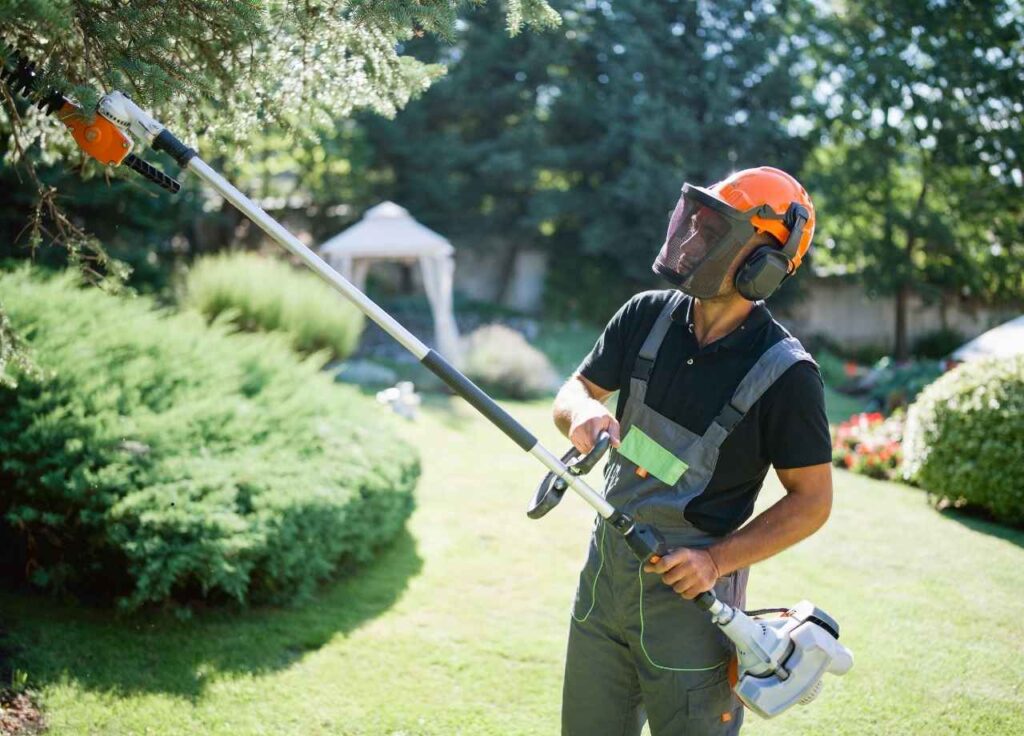Professional landscapers and tree care experts know the value of a reliable pole saw. Whether you’re clearing limbs for safety, pruning for aesthetics, or tackling overgrown properties, having the right tool for the job is critical. A well-built pole saw boosts efficiency, reduces strain, and allows you to reach difficult areas without climbing. Choosing the best model requires understanding different types, power sources, and features that contribute to productivity and safety.
At BC Industrial Supply, we work with arborists, municipal crews, and landscaping contractors across the U.S., supplying commercial-grade pole saws and offering fast shipping to keep jobs moving without delay.
Table of Contents
Understanding Pole Saws: Manual vs. Powered
Pole saws fall into two main categories: manual and powered. Manual pole saws are essentially pruning saws attached to long poles. They require physical effort and are ideal for smaller jobs where noise and emissions must be minimized. These tools are light, dependable, and perfect for precision cuts in tight spaces.
Powered pole saws, on the other hand, increase speed and reduce fatigue, making them the top choice for high-volume work. These include gas-powered, electric (corded), and battery-operated models. Each has specific advantages depending on your work environment, duration, and accessibility.
Gas-Powered Pole Saws
Gas pole saws remain the industry standard for heavy-duty trimming. They deliver consistent power, extended runtime, and are built to withstand daily use in demanding outdoor environments. Landscapers working on large properties or clearing dense brush benefit from their high torque and extended reach.
The main trade-offs are weight, noise, and emissions. These units typically require more maintenance, including regular fuel mixing, air filter cleaning, and spark plug replacement. However, for rural work sites or tree removal projects, the power-to-weight ratio often justifies the upkeep.
Look for gas models with anti-vibration features, durable shafts, and automatic oilers. Brands that offer interchangeable attachments can also add value, allowing your pole saw to double as a brush cutter, edger, or hedge trimmer.
Corded Electric Pole Saws
Corded electric models are best suited for light-duty jobs near power sources. They provide clean, quiet operation with minimal maintenance. While the range is limited by the length of your extension cord, electric pole saws are ideal for residential properties, small businesses, and urban landscaping tasks.
These saws are generally lightweight and easy to handle, making them great for newer crew members or part-time users. The consistent power output ensures smooth cutting, and many models feature tool-less chain tensioning and telescoping shafts for added versatility.
Corded units are not built for rugged use or commercial-scale projects, but they excel in situations where access is tight and the workload is light.
Battery-Powered Pole Saws
Battery-powered pole saws have surged in popularity thanks to improvements in lithium-ion battery technology. With cordless freedom, quiet operation, and no emissions, these tools strike a balance between portability and performance.

Landscaping crews often rely on battery models for mid-size tasks and areas with noise restrictions. High-capacity batteries offer 30–60 minutes of runtime, and some systems are compatible across multiple tools, streamlining operations and reducing the need for multiple chargers.
Battery-powered pole saws require less maintenance than gas models but should be stored and charged properly to extend battery life. They’re excellent for trimming branches up to 8 inches in diameter, and some higher-end models rival the cutting speed of gas.
When selecting a cordless pole saw, consider battery voltage (usually 40V or 60V), pole extension length, and motor placement. Rear-mount motors improve balance, especially at full extension, and brushless motors extend tool life while improving efficiency.
Key Features to Consider
The best pole saws for professionals aren’t just about raw power—they’re about total usability. Reach, weight, cutting capacity, and ergonomics all factor into a productive and safe day on the job.
Reach and Pole Length:
A typical professional pole saw offers a maximum reach of 10 to 15 feet. Models with telescoping poles offer more control and help reduce fatigue by avoiding awkward postures. Keep in mind that maximum extension can compromise balance, so weight distribution is key.
Cutting Head and Bar Size:
A 10-inch bar is standard for most professional applications, offering a good balance between reach and cutting capacity. Larger bars handle thicker limbs but add weight and reduce maneuverability.
Weight and Balance:
Gas models usually weigh 15–20 lbs, while battery and electric versions fall closer to 8–12 lbs. If you’re spending hours on a ladder or lift, shaving off even a few pounds can make a big difference. Look for saws with padded grips, harness mounts, and ergonomic handles to reduce strain.
Chain Tensioning and Oiling:
Tool-free chain adjustment saves time in the field, especially when working in dirty or dusty conditions. Automatic chain oilers reduce downtime and extend bar life, though manual systems offer more control in colder climates where oil flow may need adjusting.
Durability:
Commercial-grade pole saws are built with reinforced gearboxes, hardened steel components, and sealed bearings. Look for professional warranties that cover extended use and ask about serviceability—can replacement parts be ordered easily? Is the brand known for long-term support?
Safety Considerations for Tree Trimming Pros
Using a pole saw presents inherent risks. Professionals should wear appropriate PPE, including eye protection, gloves, ear protection, and helmets with face shields. Chainsaw chaps aren’t typically worn when operating pole saws from the ground, but if you’re using them on a lift or ladder, consider full leg protection.
Be mindful of power lines, wind conditions, and the direction of limb fall. Always maintain a two-hand grip and keep bystanders out of the work zone. Proper chain tension reduces kickback, and many saws now include low-kickback bars and chains as standard.
When transporting or storing pole saws, drain fuel from gas units, remove batteries from cordless models, and clean debris from around the bar and chain. Secure the blade cover and keep the saw in a dry, locked area.
Recommended Use Cases for Different Types
Gas Pole Saws:
Ideal for rural land clearing, municipal work, large properties, and commercial tree services. They shine in remote locations where portability and long runtime are needed.
Battery Pole Saws:
Excellent for HOA maintenance, golf course landscaping, school grounds, and urban work zones. They provide a quiet, powerful solution without fumes or cords.
Electric Pole Saws:
Best for light residential work, small business property care, or any situation where noise and emissions are a concern and outlet access is convenient.
Manual Pole Saws:
Useful for arborists performing close-in work or pruning specialty trees. They offer precision and minimal disruption in delicate environments.
Final Thoughts
Professional-grade pole saws are a long-term investment in efficiency, safety, and quality results. Choosing the right model for your work means considering more than just power. Look at how the saw fits into your workflow, whether it complements your other tools, and how it handles real-world conditions.
Reliable brands and models are only part of the equation. Make sure you have access to replacement chains, quality bar oil, and service support when needed. And if you’re outfitting a crew, consistency in tool platforms can make training easier and improve jobsite logistics.
Pole saws make overhead cutting safer, faster, and cleaner. Whether you’re trimming high branches or clearing storm debris, a dependable tool will help you work smarter. For contractors who want dependable access to top-tier saws, replacement parts, and expert service, BC Industrial Supply is ready to do whatever it takes to make it happen.

